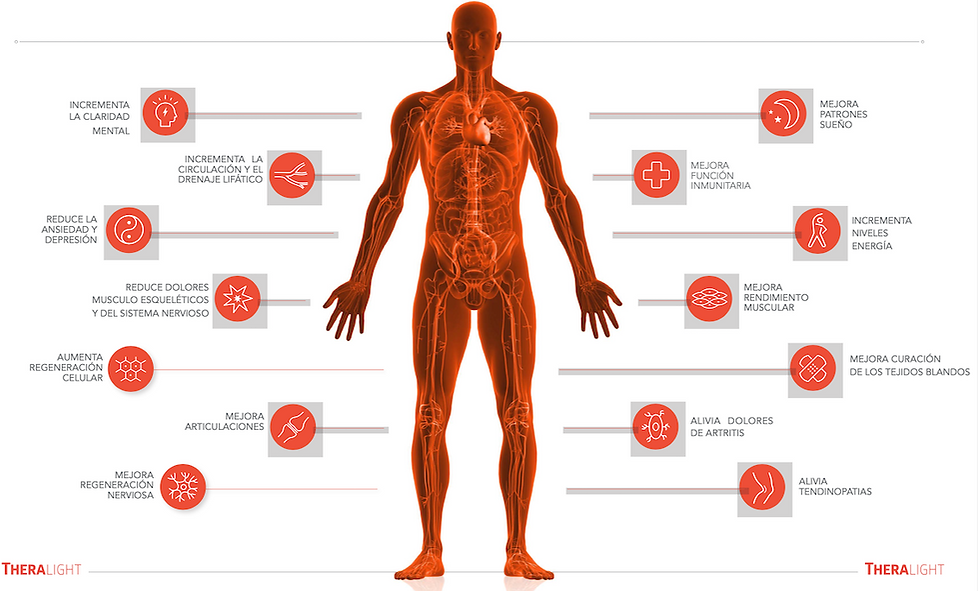
Red light therapy machine
Whole body photobiomobulation
Made in U.S.A.

Red light therapy, or photobiomodulation (PBMT), is the therapeutic application of red and near-infrared light to tissue that has been compromised by injury, disease. or degeneration.
TheraLight emits this light in four wavelengths, combined with adjustable frequencies to provide multiple application protocols.
A perfect 360° system that acts simultaneously on the entire body.
5
Reasons to choose TheraLight

The LEDs are made in Germany and have a warranty
forever

Theralight is manufactured in the USA and is registered in photomedicine as a class I and class II device with the FDA.

4 wavelengths
635 - 810 - 850 - 940
This offers effectiveness at different depths

It incorporates between 28,000 and 45,000 high intensity LEDs that ensure a radiation of between
80 and 160 mW/cm2 depending on model

Pre-established protocols in the program and the possibility of varying the frequency to adapt treatments
3
Models
Same features
Different radiation intensity

Theralight 360+
160mW/cm2

Theralight 360
100mW/cm2

Theralight FIT
80mW/cm2

Primary and secondary benefits
of red light therapy

Do you want to learn more about photobiomodulation?
A little history
Over the centuries, light has been recognized as an essential source of energy and healing. Heliotherapy (the therapeutic use of sunlight) was commonly practiced by the ancient Greeks, Romans, and Egyptians to treat various ailments. Then, in 1962, a General Electric engineer invented the first light-emitting diode (LED), opening the door to a whole new world of light-based technologies.
Light used
All light is made up of photons, which are submicroscopic particles of energy that travel in the form of waves.
In the light spectrum we place them just beyond visible light. Red and near-infrared light are characterized by long, “soft” wavelengths that penetrate tissue and transmit their restorative benefits at the cellular level.
Because TheraLight full body phototherapy systems are carefully calibrated to deliver this therapeutic light at precise frequencies, the healing effects are completely safe, completely non-invasive and with clinically proven benefits.


How Light Therapy Works
Photobiomodulation Therapy (TFBM) is the application of light that covers all wavelengths (Infrared – visible light – ultraviolet), especially red and near-infrared wavelengths for therapeutic purposes, acting on the activation of biological systems. of certain light receptor proteins, called mitochondria.
Photobiomodulation with low-level laser light (LLLT) works on the principle of inducing a biological response through energy transfer, in the sense that the photonic energy delivered to the tissue by the laser modulates the biological processes within the tissue.
Light energy is transmitted through space as waves containing small "energy packets" called photons.
Each photon contains a defined amount of energy depending on its wavelength (color). Blue photons have more energy than green photons and green photons have more energy than red or NIR photons.
The photons that are absorbed interact with an organic molecule or "chromophore" located within the tissue.
The absorption of photons by chromophobic molecules leads to electronically excited states, and consequently can lead to an acceleration of electron transfer reactions.
More electron transport necessarily leads to greater production of ATP energy by the mitochondrial respiratory chain.
The light-induced increase in ATP synthesis and increased proton gradient leads to an increase in the activity of Na+/H+ pumps and Ca2+/Na+antiporters, and of all ATP-driven carriers. , such as Na + / K + ATPase and Ca2+
Therefore mitochondria are the key to photobiomodulation.
And within these mitochondria the “Cytochrome C oxidase” proteins can absorb red light, converting photonic energy into biological energy ATP.
Cytochrome C oxidase behaves as a photon acceptor "chromophore" that catalyzes activity at the cellular level when exposed to near-infrared red light.
Absorption of colors is different within the mitochondrial respiratory chain:
Complex I (NADH dehydrogenase) absorbs blue and ultraviolet light.
Complex III (cytochrome c reductase) absorbs green and yellow light.
Complex IV (cytochrome c oxidase) absorbs red and infrared light.
With Photobiomodulation therapy, mitochondria change into "giant mitochondria" with the activation of several metabolic pathways and increased ATP production due to the activation of the respiratory chain. directly on Cytochrome C oxidase, which acts by stimulating the intracellular NF-kB pathway, which are proteins that help control many functions in the cell, such as growth and survival to stress due to cellular hypoxia and immune and inflammatory responses. Furthermore, it induces intracellular reactive oxygen species (ROS Free Radicals), which may also play a role in the NF-kB signaling pathway, and reduce cell apoptosis and a normalization of the mitochondrial membrane potential with the normalization of tissue metabolism due to the significant increase in antioxidant enzymes SOD and GTx.
